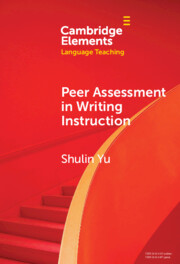Refine search
Actions for selected content:
2 results
8 - Assessment of, for and as Learning in Modern Foreign Languages
-
- Book:
- Teaching Modern Languages
- Published online:
- 04 September 2025
- Print publication:
- 12 June 2025, pp 135-151
-
- Chapter
- Export citation

Peer Assessment in Writing Instruction
-
- Published online:
- 26 January 2024
- Print publication:
- 04 April 2024
-
- Element
- Export citation
